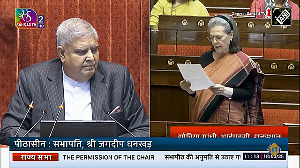The powerful Reliance conglomerate wants to break into the country's booming mobile phone market with a cheap wireless service, but it's tough.
The group, known for putting together huge projects from petrochemicals to refining, is aiming to grab one-fifth of new customers in the fast-growing market by the end of next year.
Analysts are not so sure. Reliance Infocomm is a late entrant in a fiercely competitive market where local calls can be as cheap as one or two US cents a minute. Its well-advertised roll-out was hobbled by lack of wireless services in some areas. And regulators have yet to approve its revamped service plan.
"They have kept a strict control over costs from day one, so to that extent they have an edge over others," said Anant Katare, telecoms analyst with Khandwala Securities. "But with authorities asking them to explain their low tariffs, they might have to hike their charges as a result of which the penetration they were expecting to achieve may not happen."
Reliance, which says it's setting out to make the mobile phone a mass product in the world's second-most populous nation, grabbed more than a million subscribers in a 10 week marketing blitz. That's impressive, considering the rest of the industry added 2.2 million new customers in the first quarter.
The company is investing $3.7 billion in a fibre-optic network to link over 2,500 towns and 640,000 villages.
Big opportunities
India's a mobile operator's dream. The country has just 1.3 crore (13 million) cellular subscribers, around two million limited radius mobile users and close to 4.1 crore (41 million) fixed-line subscribers. Wireless telecoms are expected to lead the sector's growth and the industry expects to have 12 crore (120 million) mobile users by 2008.
India's telecoms penetration at 5.4 per cent is far below the global average of 15 per cent. It also lags China's penetration rate of about 35 per cent with nearly 45 crore (450 million) users.
India's fixed-line companies are state-controlled firms such as Bharat Sanchar Nigam and Mahanagar Telephone Nigam, but the cellular industry has lured foreign investors.
The Bharti group's Bharti Tele-Ventures, 16 per cent owned by Singapore Telecommunications, is India's largest operator with a 25 per cent market share. Others are Hutchison Whampoa and Idea Cellular, a venture of AT&T and the Tata and Birla groups.
"We believe wireless will drive India's telecom network expansion, but one cannot discount the strength of other big names like BSNL, Bharti or Hutch," said Gartner India analyst Kobita Desai, adding Reliance had set an ambitious target.
Delayed launch
The group, which owns the petrochemicals and refining giant Reliance Industries Ltd, India's largest private company, launched its telecoms network in December. But its key selling point -- dirt-cheap tariffs -- is yet to get the green light from the telecoms regulator.
Reliance began charging for its services on May 1, after a month's delay, as it struggled to connect with other networks.
Its aggressive pricing rattled the cellular players, who are fighting the government's decision to allow fixed phone licence holders like Reliance to offer mobile services. A reciprocal inter-connect usage charge agreement kicked in on May 1 to pacify the cellular operators.
Reliance submitted new pricing plans to take into account inter-connection usage charges, but is yet to get regulatory approval, prompting fears the service may get costly.
"What Reliance wanted was to garner critical mass by creating a kind of discontinuity in the existing scheme of things," said a local brokerage analyst who did not want to be identified.
"As things have turned out, there is so much confusion that customers are probably wondering what the deal will be."
Fine print
Reliance's promotional offer locked in customers for three years with a promise of free incoming calls, cheap outgoing and long distance calls and a subsidised expensive handset.
The problem is in the fine print. The low charges only apply to Reliance's network, so calls outside could cost more if other operators charged to connect.
Reliance, which cited cost advantages from using superior technology, uses Qualcomm Inc's wireless telephone chips based on the Code Division Multiple Access technology, which is dominant in US networks.
Chairman Mukesh Ambani said at the network's launch that he aimed to grab 15-20 per cent of the market by 2004, but a company official now says he meant 15-20 per cent of new users.
"We are very confident that we will meet and even exceed our target," Amit Khanna, Reliance Infocomm spokesman, told Reuters. "By far, we are the cheapest provider - at least 8-9 times cheaper than the cellular operators."







 © 2025
© 2025